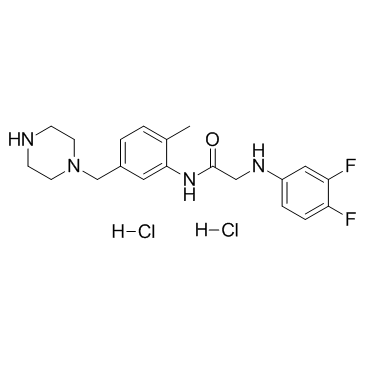GW791343 dihydrochloride |
| Catalog No.GC36202 |
GW791343 dihydrochloride is a potent human P2X7 receptor negative allosteric modulator (exhibits species-specific activity), produces a non-competitive antagonist effect on human P2X7 receptor, with a pIC50 of 6.9-7.2.
Products are for research use only. Not for human use. We do not sell to patients.

Cas No.: 1019779-04-4
Sample solution is provided at 25 µL, 10mM.
GW791343 dihydrochloride is a P2X7 allosteric modulator; exhibits species-specific activity and acts as a negative allosteric modulator of human P2X7 (pIC50 = 6.9 - 7.2). IC50 value: 7 (pIC50)Target: P2X7 in vitro: In cells expressing human P2X7 receptors, GW 791343 inhibits agonist-stimulated ethidium accumulation in both sucrose and NaCl buffer. In NaCl buffer, GW 791343 reduces the maximal response to both ATP and BzATP, but there is little effect on agonist potency except for a decrease in the presence of 300-1000 nM GW 791343. GW 791343 also reduces maximal responses to ATP and BzATP in sucrose buffer, although this effect is more marked when using ATP as agonist. In sucrose buffer, GW 791343 produces a slight decrease in ATP potency at 300 nM. GW 791343 decreases BzATP potency at concentrations of 300 nM to 10 μM. A more marked increase in agonist effect is observed when using ATP as agonist in NaCl buffer with GW791343 increasing the pEC50 and maximal response to ATP at concentrations of 10 and 30 μM. In sucrose buffer, GW791343 also increases responses when using ATP as agonist [1]. GW791343 inhibits responses at the human-rat chimeric receptor in both sucrose and NaCl buffer. GW791343 increases responses to BzATP at the F95L mutant receptor [2]. GW791343 is a non-competitive antagonist and negative allosteric modulator at the human P2X7 receptor; however, GW 791343 also acts as a positive allosteric modulator at the rat P2X7 receptor [3]. At the dog P2X7 receptor, GW 791343 is an antagonist with similar potency to that determined at the human receptor [4].
[1]. Michel AD, et al. Identification of regions of the P2X(7) receptor that contribute to human and rat species differences in antagonist effects. Br J Pharmacol, 2008, 155(5), 738-751. [2]. Felix RA, et al. Development of a comprehensive set of P2 receptor pharmacological research compounds. Purinergic Signal, 2012, 8(Suppl 1), 101-112. [3]. Roman S, et al. Cloning and pharmacological characterization of the dog P2X7 receptor. Br J Pharmacol, 2009, 158(6), 1513-1526. [4]. Michel AD, et al. Negative and positive allosteric modulators of the P2X(7) receptor. Br J Pharmacol, 2008, 153(4), 737-750.
Average Rating: 5 (Based on Reviews and 9 reference(s) in Google Scholar.)
GLPBIO products are for RESEARCH USE ONLY. Please make sure your review or question is research based.
Required fields are marked with *




















